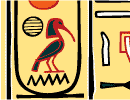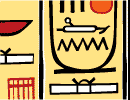The New York Times -- June 14, 1999
Egypt Excavating Huge Necropolis in Western
Desert
By THE ASSOCIATED PRESS
 AWITI,
Egypt -- Mohammed Ayadi has spent six years digging through sand and
broken rock to peek into the afterlives of long-ago residents of
Egypt's Western Desert.
AWITI,
Egypt -- Mohammed Ayadi has spent six years digging through sand and
broken rock to peek into the afterlives of long-ago residents of
Egypt's Western Desert.
He has inspected rows and stacks of 2,000-year-old mummified
remains three miles outside the Bahariya oasis town of Bawiti, then
closed the tombs again. Now, some of the 106 Greco-Roman tombs are
being excavated, and Ayadi said Sunday that some may begin to be
opened to the public within months.
"Every chamber inside is full of mummies," Ayadi, chief antiquities
inspector at the site, said as workers pulled protective plastic from
tomb No. 54, revealing both elaborately encased and simply wrapped
mummies.
Just how many mummies are beneath the four-mile strip of desert
isn't clear -- estimates run from 5,000 to 10,000-plus. Archaeologists
have found 105 mummies in the four tombs excavated in the past few
months, said Zahi Hawass, head of the team.
Hawass, speaking in Cairo on Sunday, said the tombs are "like
festivals of mummies. ... The discovery is very important because it
gives you an idea about daily life."
Ayadi, blowing fine sand away from a plaster shell known as the
cartonnage to reveal an ornately painted male face, explains what is
known about the people inside tomb No. 54.
"This is a rich family because we see decorations around the chest
and jewels in the face," he said.
Designs painted on the man's chest indicate he had four sons and
probably was athletic, explained Ayadi. His wife, also inside an
intricately painted cartonnage, was lying next to him in the chamber,
one of seven carved inside the 25-foot-by-10-foot family tomb
containing 29 bodies.
Walking to a chamber on the other end of the tomb, Ayadi nods
toward four mummies wrapped in plain linen, blackened over the
centuries. They were family, he said, but clearly less well-to-do than
the others.
Western Desert oases, including Bahariya, 215 miles southwest of
Cairo, flourished during Greco-Roman times. About two miles from the
newly excavated cemetery is the Temple of Alexander the Great, one of
many oases temples from the era.
Slight depressions of loose sand in the stony desert floor are
telltale signs of a tomb beneath. Generally, the stone ceilings have
collapsed over the years, damaging many of the mummies within.
A temporary wood ceiling protects tomb No. 54; it eventually will
be replaced with a restoration of the original.
Ayadi, who would like to one day excavate and open all 106 tombs to
visitors, said that at least No. 54 should be ready for tourists
within a couple months. Most of the mummies will stay in their
chambers, protected from overly eager visitors by glass panels.
Hotel and business owners in Bawiti, where the living number about
7,000, are hopeful that the site will open to the public soon.
Special permission from antiquities officials is needed to see many
archaeological treasures in the area, including the temple -- which is
still being excavated -- and even the town museum. Arriving without
such permission has prompted many unsuspecting tourists to cut short
their visits, hurting the local economy.
"People will hear about this (discovery)," said Saleh Sharif, owner
of the Hotel Alpenblick. "So, if they really do open it, this will be
a great thing."





